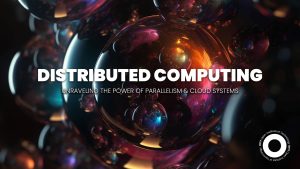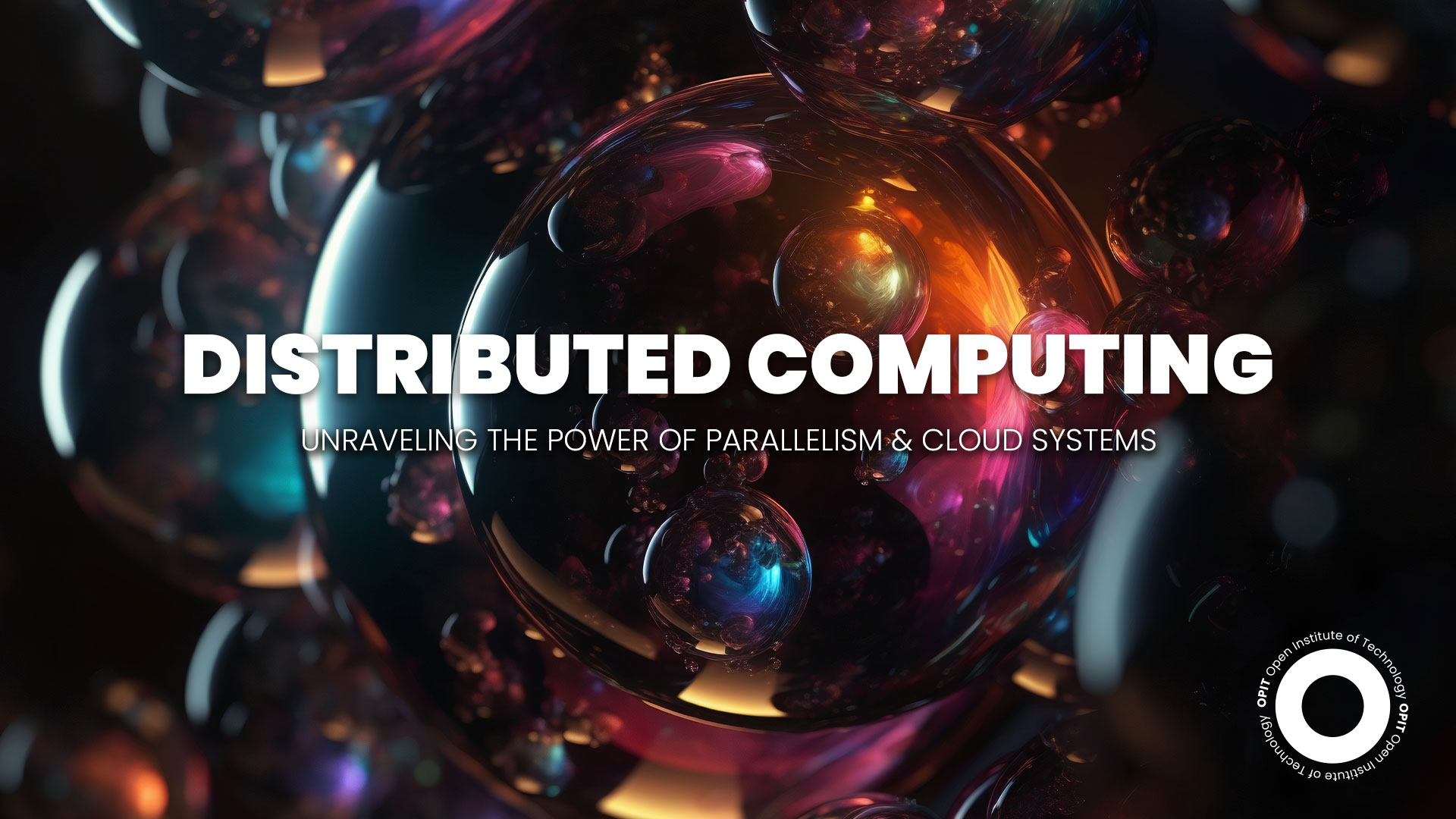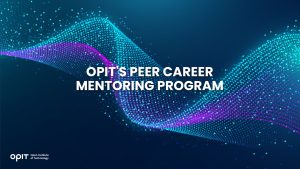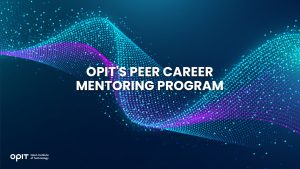

Did you know you’re participating in a distributed computing system simply by reading this article? That’s right, the massive network that is the internet is an example of distributed computing, as is every application that uses the world wide web.
Distributed computing involves getting multiple computing units to work together to solve a single problem or perform a single task. Distributing the workload across multiple interconnected units leads to the formation of a super-computer that has the resources to deal with virtually any challenge.
Without this approach, large-scale operations involving computers would be all but impossible. Sure, this has significant implications for scientific research and big data processing. But it also hits close to home for an average internet user. No distributed computing means no massively multiplayer online games, e-commerce websites, or social media networks.
With all this in mind, let’s look at this valuable system in more detail and discuss its advantages, disadvantages, and applications.
Basics of Distributed Computing
Distributed computing aims to make an entire computer network operate as a single unit. Read on to find out how this is possible.
Components of a Distributed System
A distributed system has three primary components: nodes, communication channels, and middleware.
Nodes
The entire premise of distributed computing is breaking down one giant task into several smaller subtasks. And who deals with these subtasks? The answer is nodes. Each node (independent computing unit within a network) gets a subtask.
Communication Channels
For nodes to work together, they must be able to communicate. That’s where communication channels come into play.
Middleware
Middleware is the middleman between the underlying infrastructure of a distributed computing system and its applications. Both sides benefit from it, as it facilitates their communication and coordination.
Types of Distributed Systems
Coordinating the essential components of a distributed computing system in different ways results in different distributed system types.
Client-Server Systems
A client-server system consists of two endpoints: clients and servers. Clients are there to make requests. Armed with all the necessary data, servers are the ones that respond to these requests.
The internet, as a whole, is a client-server system. If you’d like a more specific example, think of how streaming platforms (Netflix, Disney+, Max) operate.
Peer-to-Peer Systems
Peer-to-peer systems take a more democratic approach than their client-server counterparts: they allocate equal responsibilities to each unit in the network. So, no unit holds all the power and each unit can act as a server or a client.
Content sharing through clients like BitTorrent, file streaming through apps like Popcorn Time, and blockchain networks like Bitcoin are some well-known examples of peer-to-peer systems.
Grid Computing
Coordinate a grid of geographically distributed resources (computers, networks, servers, etc.) that work together to complete a common task, and you get grid computing.
Whether belonging to multiple organizations or far away from each other, nothing will stop these resources from acting as a uniform computing system.
Cloud Computing
In cloud computing, centralized data centers store data that organizations can access on demand. These centers might be centralized, but each has a different function. That’s where the distributed system in cloud computing comes into play.
Thanks to the role of distributed computing in cloud computing, there’s no limit to the number of resources that can be shared and accessed.
Key Concepts in Distributed Computing
For a distributed computing system to operate efficiently, it must have specific qualities.
Scalability
If workload growth is an option, scalability is a necessity. Amp up the demand in a distributed computing system, and it responds by adding more nodes and consuming more resources.
Fault Tolerance
In a distributed computing system, nodes must rely on each other to complete the task at hand. But what happens if there’s a faulty node? Will the entire system crash? Fortunately, it won’t, and it has fault tolerance to thank.
Instead of crashing, a distributed computing system responds to a faulty node by switching to its working copy and continuing to operate as if nothing happened.
Consistency
A distributed computing system will go through many ups and downs. But through them all, it must uphold consistency across all nodes. Without consistency, a unified and up-to-date system is simply not possible.
Concurrency
Concurrency refers to the ability of a distributed computing system to execute numerous processes simultaneously.
Parallel computing and distributed computing have this quality in common, leading many to mix up these two models. But there’s a key difference between parallel and distributed computing in this regard. With the former, multiple processors or cores of a single computing unit perform the simultaneous processes. As for distributed computing, it relies on interconnected nodes that only act as a single unit for the same task.
Despite their differences, both parallel and distributed computing systems have a common enemy to concurrency: deadlocks (blocking of two or more processes). When a deadlock occurs, concurrency goes out of the window.
Advantages of Distributed Computing
There are numerous reasons why using distributed computing is a good idea:
- Improved performance. Access to multiple resources means performing at peak capacity, regardless of the workload.
- Resource sharing. Sharing resources between several workstations is your one-way ticket to efficiently completing computation tasks.
- Increased reliability and availability. Unlike single-system computing, distributed computing has no single point of failure. This means welcoming reliability, consistency, and availability and bidding farewell to hardware vulnerabilities and software failures.
- Scalability and flexibility. When it comes to distributed computing, there’s no such thing as too much workload. The system will simply add new nodes and carry on. No centralized system can match this level of scalability and flexibility.
- Cost-effectiveness. Delegating a task to several lower-end computing units is much more cost-effective than purchasing a single high-end unit.
Challenges in Distributed Computing
Although this offers numerous advantages, it’s not always smooth sailing with distributed systems. All involved parties are still trying to address the following challenges:
- Network latency and bandwidth limitations. Not all distributed systems can handle a massive amount of data on time. Even the slightest delay (latency) can affect the system’s overall performance. The same goes for bandwidth limitations (the amount of data that can be transmitted simultaneously).
- Security and privacy concerns. While sharing resources has numerous benefits, it also has a significant flaw: data security. If a system as open as a distributed computing system doesn’t prioritize security and privacy, it will be plagued by data breaches and similar cybersecurity threats.
- Data consistency and synchronization. A distributed computing system derives all its power from its numerous nodes. But coordinating all these nodes (various hardware, software, and network configurations) is no easy task. That’s why issues with data consistency and synchronization (concurrency) come as no surprise.
- System complexity and management. The bigger the distributed computing system, the more challenging it gets to manage it efficiently. It calls for more knowledge, skills, and money.
- Interoperability and standardization. Due to the heterogeneous nature of a distributed computing system, maintaining interoperability and standardization between the nodes is challenging, to say the least.
Applications of Distributed Computing
Nowadays, distributed computing is everywhere. Take a look at some of its most common applications, and you’ll know exactly what we mean:
- Scientific research and simulations. Distributed computing systems model and simulate complex scientific data in fields like healthcare and life sciences. (For example, accelerating patient diagnosis with the help of a large volume of complex images (CT scans, X-rays, and MRIs).
- Big data processing and analytics. Big data sets call for ample storage, memory, and computational power. And that’s precisely what distributed computing brings to the table.
- Content delivery networks. Delivering content on a global scale (social media, websites, e-commerce stores, etc.) is only possible with distributed computing.
- Online gaming and virtual environments. Are you fond of massively multiplayer online games (MMOs) and virtual reality (VR) avatars? Well, you have distributed computing to thank for them.
- Internet of Things (IoT) and smart devices. At its very core, IoT is a distributed system. It relies on a mixture of physical access points and internet services to transform any devices into smart devices that can communicate with each other.
Future Trends in Distributed Computing
Given the flexibility and usability of distributed computing, data scientists and programmers are constantly trying to advance this revolutionary technology. Check out some of the most promising trends in distributed computing:
- Edge computing and fog computing – Overcoming latency challenges
- Serverless computing and Function-as-a-Service (FaaS) – Providing only the necessary amount of service on demand
- Blockchain – Connecting computing resources of cryptocurrency miners worldwide
- Artificial intelligence and machine learning – Improving the speed and accuracy in training models and processing data
- Quantum computing and distributed systems – Scaling up quantum computers
Distributed Computing Is Paving the Way Forward
The ability to scale up computational processes opens up a world of possibilities for data scientists, programmers, and entrepreneurs worldwide. That’s why current challenges and obstacles to distributed computing aren’t particularly worrisome. With a little more research, the trustworthiness of distributed systems won’t be questioned anymore.
Related posts

Source:
- Raconteur, published on November 06th, 2025
Many firms have conducted successful Artificial Intelligence (AI) pilot projects, but scaling them across departments and workflows remains a challenge. Inference costs, data silos, talent gaps and poor alignment with business strategy are just some of the issues that leave organisations trapped in pilot purgatory. This inability to scale successful experiments means AI’s potential for improving enterprise efficiency, decision-making and innovation isn’t fully realised. So what’s the solution?
Although it’s not a magic bullet, an AI operating model is really the foundation for scaling pilot projects up to enterprise-wide deployments. Essentially it’s a structured framework that defines how the organisation develops, deploys and governs AI. By bringing together infrastructure, data, people, and governance in a flexible and secure way, it ensures that AI delivers value at scale while remaining ethical and compliant.
“A successful AI proof-of-concept is like building a single race car that can go fast,” says Professor Yu Xiong, chair of business analytics at the UK-based Surrey Business School. “An efficient AI technology operations model, however, is the entire system – the processes, tools, and team structures – for continuously manufacturing, maintaining, and safely operating an entire fleet of cars.”
But while the importance of this framework is clear, how should enterprises establish and embed it?
“It begins with a clear strategy that defines objectives, desired outcomes, and measurable success criteria, such as model performance, bias detection, and regulatory compliance metrics,” says Professor Azadeh Haratiannezhadi, co-founder of generative AI company Taktify and professor of generative AI in cybersecurity at OPIT – the Open Institute of Technology.
Platforms, tools and MLOps pipelines that enable models to be deployed, monitored and scaled in a safe and efficient way are also essential in practical terms.
“Tools and infrastructure must also be selected with transparency, cost, and governance in mind,” says Efrain Ruh, continental chief technology officer for Europe at Digitate. “Crucially, organisations need to continuously monitor the evolving AI landscape and adapt their models to new capabilities and market offerings.”
An open approach
The most effective AI operating models are also founded on openness, interoperability and modularity. Open source platforms and tools provide greater control over data, deployment environments and costs, for example. These characteristics can help enterprises to avoid vendor lock-in, successfully align AI to business culture and values, and embed it safely into cross-department workflows.
“Modularity and platformisation…avoids building isolated ‘silos’ for each project,” explains professor Xiong. “Instead, it provides a shared, reusable ‘AI platform’ that integrates toolchains for data preparation, model training, deployment, monitoring, and retraining. This drastically improves efficiency and reduces the cost of redundant work.”
A strong data strategy is equally vital for ensuring high-quality performance and reducing bias. Ideally, the AI operating model should be cloud and LLM agnostic too.
“This allows organisations to coordinate and orchestrate AI agents from various sources, whether that’s internal or 3rd party,” says Babak Hodjat, global chief technology officer of AI at Cognizant. “The interoperability also means businesses can adopt an agile iterative process for AI projects that is guided by measuring efficiency, productivity, and quality gains, while guaranteeing trust and safety are built into all elements of design and implementation.”
A robust AI operating model should feature clear objectives for compliance, security and data privacy, as well as accountability structures. Richard Corbridge, chief information officer of Segro, advises organisations to: “Start small with well-scoped pilots that solve real pain points, then bake in repeatable patterns, data contracts, test harnesses, explainability checks and rollback plans, so learning can be scaled without multiplying risk. If you don’t codify how models are approved, deployed, monitored and retired, you won’t get past pilot purgatory.”
Of course, technology alone can’t drive successful AI adoption at scale: the right skills and culture are also essential for embedding AI across the enterprise.
“Multidisciplinary teams that combine technical expertise in AI, security, and governance with deep business knowledge create a foundation for sustainable adoption,” says Professor Haratiannezhadi. “Ongoing training ensures staff acquire advanced AI skills while understanding associated risks and responsibilities.”
Ultimately, an AI operating model is the playbook that enables an enterprise to use AI responsibly and effectively at scale. By drawing together governance, technological infrastructure, cultural change and open collaboration, it supports the shift from isolated experiments to the kind of sustainable AI capability that can drive competitive advantage.
In other words, it’s the foundation for turning ambition into reality, and finally escaping pilot purgatory for good.

The Open Institute of Technology (OPIT) is the perfect place for those looking to master the core skills and gain the fundamental knowledge they need to enter the exciting and dynamic environment of the tech industry. While OPIT’s various degrees and courses unlock the doors to numerous careers, students may not know exactly which line of work they wish to enter, or how, exactly, to take the next steps.
That’s why, as well as providing exceptional online education in fields like Responsible AI, Computer Science, and Digital Business, OPIT also offers an array of career-related services, like the Peer Career Mentoring Program. Designed to provide the expert advice and support students need, this program helps students and alumni gain inspiration and insight to map out their future careers.
Introducing the OPIT Peer Career Mentoring Program
As the name implies, OPIT’s Peer Career Mentoring Program is about connecting students and alumni with experienced peers to provide insights, guidance, and mentorship and support their next steps on both a personal and professional level.
It provides a highly supportive and empowering space in which current and former learners can receive career-related advice and guidance, harnessing the rich and varied experiences of the OPIT community to accelerate growth and development.
Meet the Mentors
Plenty of experienced, expert mentors have already signed up to play their part in the Peer Career Mentoring Program at OPIT. They include managers, analysts, researchers, and more, all ready and eager to share the benefits of their experience and their unique perspectives on the tech industry, careers in tech, and the educational experience at OPIT.
Examples include:
- Marco Lorenzi: Having graduated from the MSc in Applied Data Science and AI program at OPIT, Marco has since progressed to a role as a Prompt Engineer at RWS Group and is passionate about supporting younger learners as they take their first steps into the workforce or seek career evolution.
- Antonio Amendolagine: Antonio graduated from the OPIT MSc in Applied Data Science and AI and currently works as a Product Marketing and CRM Manager with MER MEC SpA, focusing on international B2B businesses. Like other mentors in the program, he enjoys helping students feel more confident about achieving their future aims.
- Asya Mantovani: Asya took the MSc in Responsible AI program at OPIT before taking the next steps in her career as a Software Engineer with Accenture, one of the largest IT companies in the world, and a trusted partner of the institute. With a firm belief in knowledge-sharing and mutual support, she’s eager to help students progress and succeed.
The Value of the Peer Mentoring Program
The OPIT Peer Career Mentoring Program is an invaluable source of support, inspiration, motivation, and guidance for the many students and graduates of OPIT who feel the need for a helping hand or guiding light to help them find the way or make the right decisions moving forward. It’s a program built around the sharing of wisdom, skills, and insights, designed to empower all who take part.
Every student is different. Some have very clear, fixed, and firm objectives in mind for their futures. Others may have a slightly more vague outline of where they want to go and what they want to do. Others live more in the moment, focusing purely on the here and now, but not thinking too far ahead. All of these different types of people may need guidance and support from time to time, and peer mentoring provides that.
This program is also just one of many ways in which OPIT bridges the gaps between learners around the world, creating a whole community of students and educators, linked together by their shared passions for technology and development. So, even though you may study remotely at OPIT, you never need to feel alone or isolated from your peers.
Additional Career Services Offered by OPIT
The Peer Career Mentoring Program is just one part of the larger array of career services that students enjoy at the Open Institute of Technology.
- Career Coaching and Support: Students can schedule one-to-one sessions with the institute’s experts to receive insightful feedback, flexibly customized to their exact needs and situation. They can request resume audits, hone their interview skills, and develop action plans for the future, all with the help of experienced, expert coaches.
- Resource Hub: Maybe you need help differentiating between various career paths, or seeing where your degree might take you. Or you need a bit of assistance in handling the challenges of the job-hunting process. Either way, the OPIT Resource Hub contains the in-depth guides you need to get ahead and gain practical skills to confidently move forward.
- Career Events: Regularly, OPIT hosts online career event sessions with industry experts and leaders as guest speakers about the topics that most interest today’s tech students and graduates. You can join workshops to sharpen your skills and become a better prospect in the job market, or just listen to the lessons and insights of the pros.
- Internship Opportunities: There are few better ways to begin your professional journey than an internship at a top-tier company. OPIT unlocks the doors to numerous internship roles with trusted institute partners, as well as additional professional and project opportunities where you can get hands-on work experience at a high level.
In addition to the above, OPIT also teams up with an array of leading organizations around the world, including some of the biggest names, including AWS, Accenture, and Hype. Through this network of trust, OPIT facilitates students’ steps into the world of work.
Start Your Study Journey Today
As well as the Peer Career Mentoring Program, OPIT provides numerous other exciting advantages for those who enroll, including progressive assessments, round-the-clock support, affordable rates, and a team of international professors from top universities with real-world experience in technology. In short, it’s the perfect place to push forward and get the knowledge you need to succeed.
So, if you’re eager to become a tech leader of tomorrow, learn more about OPIT today.
Have questions?
Visit our FAQ page or get in touch with us!
Write us at +39 335 576 0263
Get in touch at hello@opit.com
Talk to one of our Study Advisors
We are international
We can speak in:


